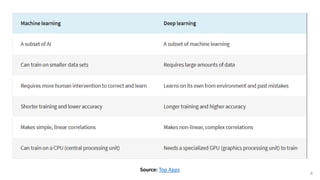Understanding Convolutional Neural Networks (CNN)
- 1. Convolutional Neural Network By Mohamed Gamal © Mohamed Gamal 2024
- 2. Agenda ▪ What is CNN? ▪ Architecture and Components of CNN ▪ Advantages of CNN ▪ Disadvantages of CNN 1
- 3. ▪ Convolutional Neural Networks (CNNs) come under the subdomain of Machine Learning which is Deep Learning. ▪ CNN is a supervised type of Deep learning. ▪ Algorithms under Deep Learning process information the same way the human brain does, but obviously on a very small scale, since our brain is too complex (our brain has around 86 billion neurons). What is CNN? 2 Image by Roger Brown Image from a paper by Rahul Kumar Sevakula
- 4. 3 Source: Software Testing Help
- 6. Components of CNN General Architecture of Convolutional Neural Networks (CNN) Flattening feature extraction Classification Convolution + Activation & Pooling Output Hidden Layer 5 Source: ByteByteGo
- 7. Convolution + Activation Convolution + Activation Pooling Pooling Feature Extraction Classification Activation Function (e.g., Softmax) Feature Maps Probabilistic Distribution Fully Connected Layer + Dropout Layer Components of CNN (Cont.) Hidden Layer (1D Feature Vector) 6 Image Source
- 9. Feature Extraction ▪ Convolutional layer ▪ Pooling layer ▪ Activation functions ▪ Flatten Layer ▪ Fully Connected Layer ▪ Dropout Layer ▪ Output Layer Components of CNN in detail
- 10. Convolutional Layer • Convolutional layer: the primary purpose of convolution is to extract features from the input image. Average Filter 9 Images Source
- 11. Convolutional Layer (Cont.) 3D Image Convolution 10 Source Source
- 12. Laplacian Filter (Sharpening) Gaussian Filter (Smoothing) Average/Mean Filter (Smoothing) Convolutional Layer (Cont.) Original Image Average Filter 11 3D View 2D View Images Source
- 13. Pooling Layer • Pooling Layer: a down-sampling operation that reduces the dimensionality of the feature map, but retains important information. ▪ Max Pooling, Min Pooling, Average Pooling, Sum Pooling … etc. 15
- 14. Activation Functions • Activation functions: introduce non-linearity to the network, allowing it to learn complex patterns in the data. ▪ ReLU (e.g., Image/Object Classification— Non-linear) ▪ Sigmoid (e.g., Binary Classification — Non-linear) ▪ Linear (e.g., Linear Regression) ▪ Tanh (e.g., Multiclass Classification — Non-linear) ▪ Softmax (e.g., Multiclass Classification — Non-linear) ▪ ⋮ 12
- 15. Activation Functions (Cont.) 13 • Table 4.1 can help you choose a last-layer activation function for a few common problem types.
- 16. ReLU max(0, 𝑥) Linear 𝑓(𝑥) = 𝑥 Sigmoid 𝜎 𝑥 = 1 1 + 𝑒−𝑥 Tanh tanh(𝑥) Softmax Softmax 𝑍𝑖 = 𝑒𝑧𝑖 σ𝑗=1 𝐾 𝑒𝑧𝑗 , for 𝑖 = 1, … , 𝐾 0 0.5 14
- 17. Flatten Layer • Flatten Layer: used to convert the multidimensional output of the previous layer into a 1D array. 1D 16
- 18. Fully Connected (FC) Layer • Fully Connected Layer: takes 1D input from the previous layer (i.e., Flatten Layer) and computes the class scores and outputs the 1D array of size equal to the number of classes. Activation Function (e.g., Softmax) Softmax Activation: Used to produce probability distribution over classes. 𝐾 = 5 𝑧1, 𝑖 = 1 𝑧2, 𝑖 = 2 𝑧3, 𝑖 = 3 𝑧4, 𝑖 = 4 𝑧5, 𝑖 = 5 Output = 1 17 𝑗=1 𝐾=5 𝑒𝑧𝑗 = 181.7341362 𝑒1.3 181.7341362 = 0.02
- 19. Dropout Layer • Dropout Layer: — The term "dropout" refers to dropping out some nodes. — A regularization technique used to help prevent overfitting, focusing on generalization of the model. — The nodes are dropped by a dropout probability 𝑝. ▪ For instance, if the hidden layers have 1000 neurons (nodes) and a dropout is applied with drop probability 𝑝 = 0.5, then 500 neurons would be randomly dropped. — Dropout can be used, for example, after convolutional and pooling layers in feature extraction process, however, it is typically added after or with the fully connected layer. 17
- 21. Advantages of CNNs ▪ No human supervision. ▪ High accuracy at image recognition and computer vision. ▪ Minimize computation. ▪ Exploit the spatial and hierarchical structure of the images. 18
- 22. Disadvantages of CNNs ▪ Classification of images/objects with different Positions and orientations. ▪ A lot of training data is needed. ▪ Training process takes a long time (slow). ▪ Prone to overfitting 19
- 23. CNN Visualizer TensorFlow CNN Playground 20
- 24. ThankYou!
























